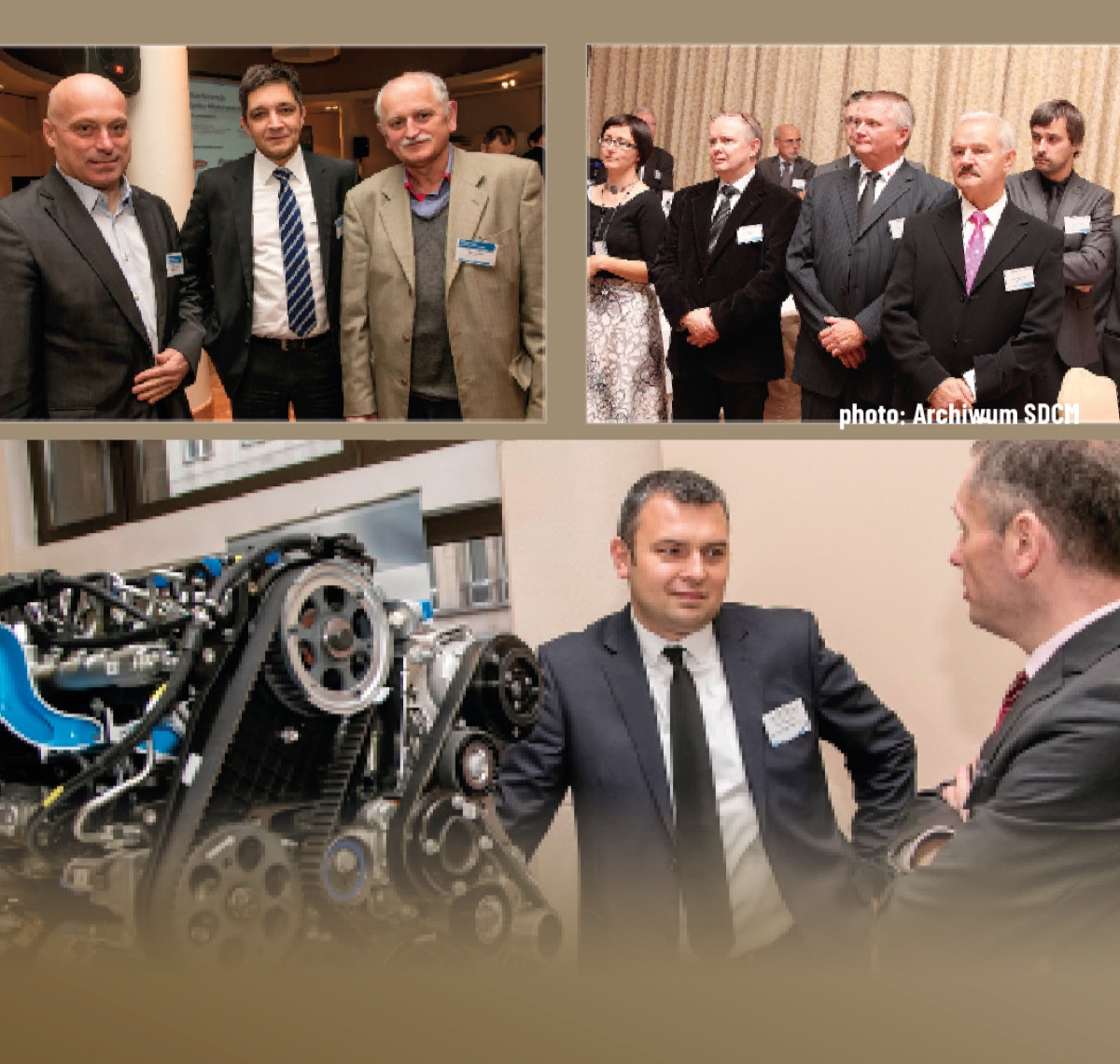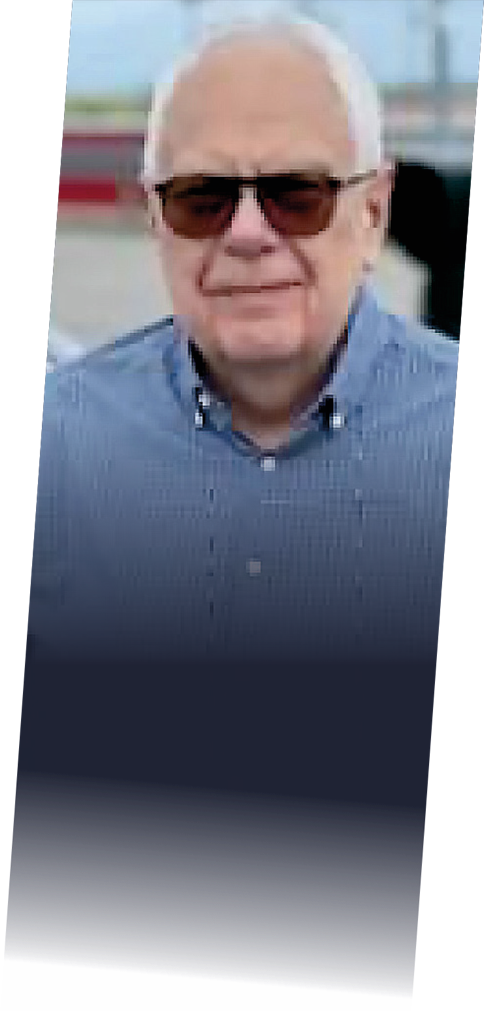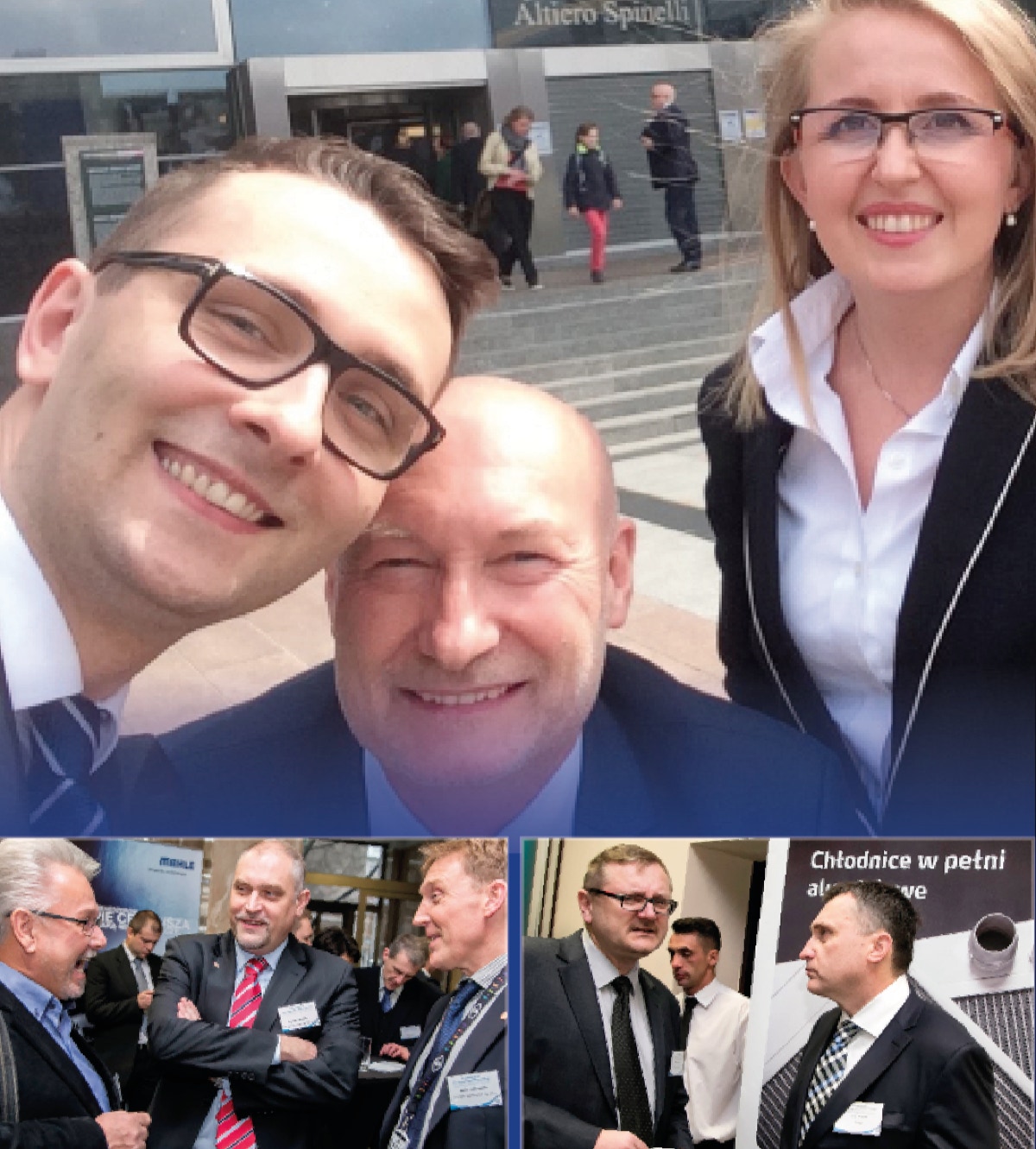
MOTORING | YESTERDAY | TODAY | TOMORROW

chapter 4

MOTORING | YESTERDAY | TODAY | TOMORROW

chapter 4
Alfred Franke: Our conversation has been rather casual and anecdotal, meanwhile, SDCM’s undertakes very serious activities aimed at defending the interests of automotive companies and, consequently, thousands of jobs....
AF: I now realize that I tend to run rather than walk, as I’ve heard complaints about this from people who have accompanied me during various events, such as trade fairs. I’ve also been accused of blowing papers off people’s desks as I pass by them. But this is the first time I’ve heard about my alleged bilocation, as well as the quantum theories about me (laughter).
Krzyszto Oleksowicz: I can confirm that Alfred is known in the industry for being hard to keep up with, and in all the years that he has been the CEO of SDCM, he has had the opportunity to get a fair share of running, including obstacle runs in both Polish government offices and European institutions.
AF: Ok, I’ve lightened up now (laughter). Let’s start with the fact that there have been numerous attempts at establishing the association and countless meetings of distributors initiated by different people. However, it took a while to find a common ground. I happened to participate in those meetings as a representative of the industry media. I knew everyone from my days back in parts distribution, but I was no longer associated with any distributor. So I was perceived not as one of the competitors but as someone completely impartial, although closely connected to the industry. Suddenly, one day, Christopher called me to ask if I could form an industry organization on behalf of several distributors.
KO: We, as distributors, have been persuaded to establish and get organized into an association by FIGIEFA, a European organization of national industry associations. In 2004, Poland became a member state of the European Union and got to co-create its policies. What we needed was an institution that would be capable of reaching Polish decision-makers. The task of creating the organization was unanimously entrusted to Albert. Simply put, we all felt that he was suited for this task like no one else, not only because he was not associated with any company, but mainly because he was an efficient organizer and negotiator. On top of that, he was a man of legendary diligence, which even became an object of affectionate jokes.
AF: So there was a founding meeting, at which, in addition to Christopher and myself, there were several other heads of other distribution companies. The very fact that such a meeting was held was quite unusual in itself because otherwise, those distributors competed fiercely with each other and sometimes held various grudges against each other. But that day, they decided to put them all aside.
KO: It was indeed an event of great significance, especially if one takes into account our national vice, that is, our quarrelsome nature. It is said that where there are two Poles, there are three opinions, and in that case, there were several of us, and we all had one resolve - to establish an association and entrust its organization to Alfred.
AF: When I was asked to do it, I had already been involved in developing MotoFocus, which I still wanted to continue. I decided that establishing the association was a great idea that could be enhanced by the synergy between my media activity and the needs resulting from the lobbying activities. I agreed immediately and swiftly convened a founding meeting. It was attended by fourteen companies - more than I expected. It was a heartening moment to see the hitherto competitors engaged in a discussion about their future together.
AF: Undoubtedly, the project to introduce a repair clause, that is, a provision allowing the trade of aftermarket parts for salvage repairs, was significant. This was a period when car makers were reserving the rights to designs of components such as bumpers, hoods, fenders, etc. on a massive scale, thus wanting to eliminate independent distributors from the market. The sales of these products was the core business of many companies. We began working closely with the aforementioned international federation, FIGIEFA, as well as the European alliance for the freedom of repairs, ECAR.
I remember my conversation with Gerard Riehle, the head of ECAR. I told him how stressed I was in my new role, since all my life I had been into the car parts business, not lobbying. And he said: “And it’s very good that you have such experience. Now you will sell the idea.” That short conversation cleared up all my doubts. And that’s how I started my adventure in “trading” a completely new product (laughter).
KO: For all of us, representatives of the young independent automotive market in Poland, acting in a public forum, both domestic and European, was a completely new experience. So, Alfred had to jump right in at the deep end. Unexpectedly for us, SDCM members, and for Alfred himself, it turned out that he could not only swim but he was also good at it.
AF: Not only did you have to swim, but you also had to carve your way through the ice like an icebreaker (laughter). I remember meeting with a certain MP to persuade him of the merit of the proposed solutions. Before I even said anything, he asked if there was any company in our organization from his constituency. If so, he would be happy to help us. Otherwise, he had no time for us. In the beginning we bounced around a lot like that.
AF: Well, we encountered other obstacles: They'd say: “Well, yes, but you represent only ‘dealers,’ not manufacturers. And we are interested in factories - we would be happy to help them.” This was a clear signal that we needed to get stronger and invite manufacturers to join us. And then there was a sudden breakthrough in the way the politicians perceived our Association.
KO: And it did strengthen us. Previously, the decision-makers who shaped the whole legal environment of our industry didn’t have the faintest idea about the automotive market. For them, parts distributors were seen as some kind of wholesalers who didn’t mean much.
AF: I don’t know if you remember how I once brought an important official from the ministry to your warehouse in Czosnów. When I came to pick him up, he said with a wince: “Mr. Alfred, I understand that you are taking me to something between a dealership and a chicken coop.” I didn’t even respond and just changed the topic. But it was nice to see the look on his face when he saw the 15,000-square-meter high-bay warehouse. Suddenly, he was willing to listen to what we had to say, although previously all the letters and presentations would disappear forever in the vast ministerial drawers.
KO: I remember those tours for decision-makers organized by Alfred. We admired the power of his gentle persuasion and his personal charm, because in those days, getting an important official to attend such a tour was a big deal.
AF: It should be added that initially he wasn’t inclined to help us, which he made clear to us especially when we were lobbying for reasonable regulations on parts approval. And then later we held press conferences together. But let me say this for the record - winning the favour of decision-makers did not necessarily mean getting things done.
KO: That’s when Alfred got the idea that since he was supposed to “sell ideas,” as Gerard Riehle once said, a good thing would be to introduce some marketing into it. So he started organizing various campaigns with such flair and ingenuity that many professional public event organizers could learn from him (laughter).
AF: We had to find some idea of how to get our message across. At that time, I held regular meetings with a certain director at the ministry. Whenever I articulated our demands to him, he’d just nod, pat me on the back and change the topic. No reaction. We could not get anyone important to help us. We felt like we were running out of time. Well, so, a little out of desperation, we decided to resort to trick. We ordered mouse pads with special graphics on them and hired hostesses who then handed them out to all the officials entering the ministry. The whole event was observed by the journalists we had invited. Guess what? The following day, things finally took off.
AF: It was made especially for SDCM. We would send them along with a letter outlining the demands of the industry to all the MPs we had contact with. The puzzle came with an instruction: put it together and find five differences. It makes me want to laugh when I picture dignified MPs sitting in the parliament and putting that puzzle together.
But I guess we were right to anticipate that it would be the children of the decision-makers, and maybe even their grandchildren, who would do the work for us and brag about how quickly they’d found the differences in the pictures. Those magical differences showed how the market would have changed if the regulation we demanded had not been introduced. The campaign was incredibly successful. You could just feel the change in attitude of the majority of MPs.
AF: I would say that they made our demands resonate in the public forum, which inevitably meant that decision-makers had to take an interest in them. Do you remember that event with ponies? At one point, supermarkets started to sell pink, plush ponies. Some of them cost two zloty, and some ten. The only difference between them was that the more expensive ones were marked with a square, which symbolized the car manufacturer's logo, and the cheaper ones had a circle, a trademark symbolizing an independent manufacturer. Those customers who chose the cheaper mascots, and it turned out that 98% of them did, were then asked to sign a petition.
The effect was amazing, as we managed to collect more than 100,000 signatures in favour of the repair clause, while the money earned from the sale of the mascots went to charity. Of course, this would not have been possible without the help of a broader coalition of entities supporting our cause.
KO: The repair clause was our big win and a huge success for everyone from the industry. It was also an important proof for the organization’s members of the significance of its activities. It helped make people believe that they do have a say and can make things change. Additionally, it proved that you can achieve a great deal thanks to hard work and creativity. When the repair clause went into effect, no one questioned the significance of SDCM anymore. It really worked well for all of us.
AF: In retrospect, I have to say that we probably wouldn’t have gotten anywhere with the repair clause if the community representing the interests of the car corporations hadn’t completely disregarded us. They ignored us entirely. But when they finally woke up, it was too late. At some point, though, they began to lobby hard against the clause, and they succeeded to certain extent, as the case got stuck somewhere along the way. Luckily, though, it had already been present in the public discourse for some time, so it could no longer be completely disregarded by the policymakers.
AF: Things had started to roll. When we started our attempts at pushing the repair close through the parliament, the car manufacturers had reserved the shapes of 70 most popular components. Two years later, that figure grew to more than 400.
AF: We were very clear about our point of view right from the very start - the repair clause is a fair solution, because it protects car manufacturers from their products being copied, but at the same time, it prevents them from stretching this protection to individual vehicle replacement parts, and in this context is supports the entire independent market. Let me just stop here, because I could go on like this until the morning about it.
KO: Soon SDCM gained additional prominence, as it joined FIGIEFA and then CLEPA, thus sailing into international waters.
AF: You could say so. We also became active in Brussels, where we met with the Polish members of the European Parliament. It turned out that the European perspective somehow mitigated the political divisions. Polish MEPs spoke with one voice on important issues. So, we had support from representatives of all political options. By the way, I remember the days spent in Brussels as exceptionally busy. I would run from one meeting to another, sometimes having as many as eight per day, navigating the entire parliament building like crazy. I explained the situation, the industry’s demands, emphasizing how many jobs depended on the solutions that would be introduced. We even held working breakfasts in the parliament building, during which we presented the latest market reports.
AF: It’s true, it was tough, but the satisfaction I got from the conversations during which I convinced MEPs of our arguments made the fatigue pass and I had the energy to work again the following day. In 2008, the future of GVO, which was to expire in 2010, was to be decided, and the shape of these regulations was crucial to the functioning of the independent automotive market.
KO: This grassroots work, i.e., “educating” decision-makers in the Polish parliament, the government and the European Parliament, was influenced by elections, during which important politicians would frequently be replaced.
AF: That was probably the biggest problem. Referring to that metaphor you mentioned earlier, according to which my job was to sell ideas, you could say that after the elections, we’d lose our existing clients and had to acquire new ones.
KO: Before SDCM, the automotive market was understood to mean only the sale of cars, and the automotive industry was synonymous with their production. The independent market was not recognized at all.
AF: That’s because the government had eventually noticed us. We had finally managed to make them understand that it was us who represented the industry, which provided hundreds of thousands of jobs. So, it became easier for us to reach out to legislators, especially regarding parts approval and the implementation of European regulations. It should be pointed out that the original draft bills were extremely unfavourable for Polish entrepreneurs and put them in a very difficult position as regards the competition with companies operating in other European countries.
KO: We should also mention one more aspect of SDCM’s activities, namely all those studies that provided plenty of very valuable data on the market, which has also been very helpful to us as members of the Association in creating our strategies.
AF: That's true. For example, our study on telematics was absolutely unique. FIGIEFA itself claimed that it was the first document ever to contain so much data on this field: therefore, it has been used across the entire Europe, not only with regard to Polish decision-makers.
AF: It was a very important report because it proved that the actual average age of Polish cars was much lower than that shown in the CRV registers. According to these registers, there were more Syrena than Toyota Yaris cars in Poland, and that 23,000 registered vehicles were older than the first mass-produced car, the Ford T. These false statistics were used to justify the restriction of imports of used vehicles and prevent a surge in scrapped cars flooding the country. It’s also worth recalling that at the beginning of the 2000s, analysing the Polish market and its potential was incredibly difficult, because the CRV data was completely removed from reality. In fact, we still have false data on automotive companies in Poland, for example.
According to the official data, there are more than 90,000 garages in our country, which is a completely fabricated figure. This results from the official statistics categorizing individuals working under B2B contracts as separate garages. For example, if four mechanics work in the same garage underB2B contracts, they will be counted as four distinct automotive companies in the official statistics. Adding the owner of the garage to this count brings the total figure to 5.
KO: A rough estimate shows that the actual number of garages ranges between 24-25 thousand. At the same time, we’ve been hearing that the market is shrinking because, unfortunately, more garages are suspending their operations than new ones are being set up.
GK: The report on ‘dead souls’ in the CRV was, of course, accompanied by an artistic component, providing additional context and insight.
AF: We organized a small event. We rode on a rented English vintage double-decker bus between the Parliament and the Ministry of Economy, accompanied by a group of journalists, and had a group of young people shout through a megaphone that there were nearly 7 million ‘dead souls’ in the register. Thanks to our actions, those outdated entries are still visible in the official databases but are at least classified as archival. Fortunately, no one sane relies on them to determine the number of cars on Polish roads or their average age.
AF: That’s right. It featured young professional actors. The play was devoted to the activities of vehicle inspection stations. SDCM not only prepared a detailed report on the subject and a list of demands that, if implemented, would significantly improve the situation, but also employed high-brow art in its activities (laughter). This approach proved successful as it gained attention from both the media and politicians, though the journey is not complete yet.
KO: Well, to start with, when Alfred mentioned that he wanted to hand over the reins of the association to someone else after having managed it for so many years, all the members’ first reaction was to talk him out of it. Simply put, he was so important to all of us, that we just could not imagine how SDCM would manage without him. Fortunately, he did it his style, ensuring that this change would be seamless. Consequently, the association continues to operate as smoothly as ever.
AF: That’s what I cared about the most, not only because I wanted to stay loyal to you all, the companies that trusted me years ago, but also because I am emotionally connected to SDCM. It’s been an important part of my life, and that’s why I really wanted to see it flourish. Today, it is managed by Tomek Bęben, who’s been doing an excellent job as its head. I am always ready to help him or the other members, if need be. I remain at your disposal.
KO: To finish this topic off, I can assure you that we do not treat this declaration as pure courtesy and that we will be happy to use your help.
KO: In the 2000s, as far as the major players are concerned, there weren’t many changes, because a barrier to entry had already been created. On the other hand, the companies that were established in the early 1990s took the wind in their sails, although some of them were blown out of the water. In any case, this was already a time when it was impossible to enter the market just like that, even if you had substantial capital at your disposal. I remember that somewhere around 2000, a friend of mine asked me if the parts market was cool.
I mentioned that it was very cool; the business was thriving with a growing number of cars, and overall, it was doing great. So he said he’d talk to his father, because they had some money to invest and they were thinking of getting into the distribution market. But in an established market like ours, that was not an easy thing to do. To use a western movie metaphor - the territories west of the Mississippi had already been taken.
AF: I don’t see this happening in the foreseeable future. The Polish distributors are too agile thanks to having been exposed to such fierce competition, so they won’t be easily fooled.
KO: For now, they are just waiting and complaining to suppliers. In the past, when, for instance, German distribution companies lamented their challenges to German manufacturers, it worked. The manufacturers, in solidarity with their long-time partners, would advise us to stick to the Polish market. However, as Western distribution companies have become international, acquired by various investment funds, this dynamic has shifted. Suppliers now openly assert that Europe is the sales market for European manufacturers, and Polish distributors, being European companies, happen to fall under this umbrella.

Maciej Trociński
former long-time CEO of Hella PolskaHow important is the Repair Clause from the point of view of the large, global alternative spare parts manufacturers?
The Repair Clause gives car manufacturers full protection for their car designs. As far as alternative parts manufacturers are concerned, the clause guarantees them the right to supply the parts they produce, shaped exactly as the original parts, to be used on all cars in all EU countries, in which the clause applies. And then there is the consumer, who gets to choose the parts that will be used to repair their vehicle. From the point of view of an alternative parts manufacturer, the Repair Clause promotes competition, innovation and investment. And what exactly does this mean?
A car design is something that catches the buyer’s attention and interest in a particular car model. To be competitive, it must stand out from other designs in its category in terms of shape. The external appearance and performance of a car is of great importance to a potential customer.
As much as this analogy applies to vehicles, it does not apply to replacement parts. These components simply have to fit, as they are used to restore the original appearance of a car in the process of its repair. This means that they must be identical with the original parts they are to replace. And this is why the Repair Clause is so important - it protects the overall design of the car, but not its individual components. In this case, there are no alternatives regarding appearance.
Therefore, manufacturers of replacement parts have a choice - they can either produce parts that look exactly like the originals or to collectively withdraw from the visible parts aftermarket.
This, however, would result in a monopoly of car manufacturers, as drivers would be forced to buy replacement parts only from them.
Let me give you another example to illustrate this situation. When you buy a car, it becomes your property. If it breaks down, you have to repair it. But what If you decide to redecorate your house? Will you buy new windows or other items from the architect who designed it? And what about clothes? If you want to mend them, do you take them to the store where you bought them? Well, you don’t. Therefore, no one should be forced to buy visible replacement parts to repair their car from the company that manufactured the car. In the absence of the Repair Clause, customers would be forced to use car manufacturers’ services and buy their parts throughout the entire life cycle of their car.
However, the customer should have the right to choose, just as the entrepreneur should have the right to compete in the market to establish their place in the hierarchy of the supply chain. At the same time, the clause, just like any other mechanism regulating the competition in the market, serves as an incentive for the manufacturers to continually improve their products, work on innovative solutions, and invest in the development of their business on multiple levels.

